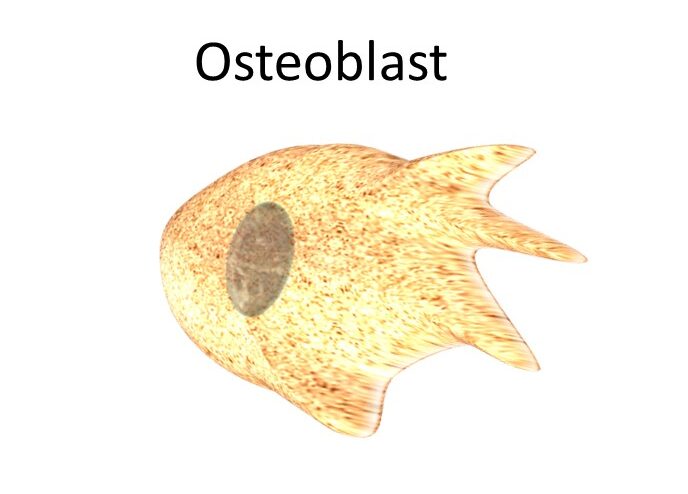Osteoblast definition: Osteoblast (“Osteo” means bone & “blast” means formation) is a uni-nucleated cell, produced from pluripotent mesenchymal stem cells. Osteoblast’s function is essential for mineralization and synthesis of bone during both bone formation and bone remodeling.
They are found in bone marrow as a single cell or group of cells. The osteoblast is also converted into chondrocytes, muscle cells, and adipocytes.
In general, matured osteoblast is surrounded by a growing calcified bone matrix; thus, the cell is trapped in a space called lacuna.
The trapped osteoblast later becomes a specialized cell called osteocyte, or bone cell. Osteocytes can interconnect with each other as well as with free surfaces of the bone through widespread cytoplasmic progressions that occupy long meandering channels (canaliculi) via bone matrix.
Osteoblasts contain a smaller number of cell organelles compared to other bone cells (e.g. Osteoclast), which includes lysosomes, mitochondria, and vacuoles.
Osteoblast function
Osteoblasts can synthesize many cellular molecules including structural proteins, hormones, and enzymes as well as growth factors.
- Structural protein – Collagen.
- Enzymes – Alkaline phosphatase and collagenase.
- Hormone – Osteocalcin, (also called as bone gamma-carboxy glutamic acid-containing protein (BGLAP), which is a noncollagenous protein hormone present in the bone and dentin).
- Growth factor – Insulin-like growth factors I and II, transforming growth factor, platelet-derived growth factor, fibroblast growth factor, and bone morphogenetic proteins.
- Osteoblast also produces an organic unmineralized component of the bone known as osteoid. Osteoid will be produced in the form of several specific proteins which are essential for the formation of bone tissue.
Osteoblast function in osteoclast differentiation
Recent studies on interactions between Receptor Activator of NF-Kappa B (RANK) and RANK ligand (RANKL) discovered the well-known hypothesis that osteoblasts play an important role in osteoclast cell differentiation. Osteoblasts express a membrane-associated factor RANKL on their membranes. While, osteoclast precursor cells express a receptor, RANK on their cell membrane. RANKL and RANK interactions (cell-cell interaction) recognize a differentiation of osteoclast precursor cells into osteoclasts. Thus, osteoblast function is also responsible for osteoclast differentiation.
Osteoblast-independent differentiation of Osteoclast
The studies have found that lipopolysaccharide and inflammatory cytokines including tumor necrosis factor receptor-alpha and interleukin-I directly induce the osteoclast differentiation and function, this mechanism is independent of osteoblast function and RANKL-RANK interaction. Interferon-gamma and transforming growth factor-beta superfamily members are also found to be important factors for osteoclastogenesis. These studies have provided new strategies for analyzing the molecular mechanisms involved in osteoblast and osteoclast differentiation.
Osteoblast differentiation
Recent studies in bone cell biology significantly changed the conceptions regarding regulatory mechanisms involved in the differentiation of osteoblasts and osteoclasts.
Invertebrates, bone is frequently destroyed and reformed to keep the constant bone volume and calcium homeostasis throughout their lives. Osteoblasts and osteoclasts are specialized cells for bone volume maintains. Osteoblast’s function is required for bone formation, while osteoclasts are responsible for resorption.
In osteoblasts differentiation, bone morphogenetic proteins (BMPs) play a critical role. The studies on Smad-mediated signals discovered the particular functions of BMPs in osteoblast differentiation.
Runx2 and Osterix are known transcription factors found to be important molecules for inducing the differentiation of osteoblast cells. Smad transcriptional factors are shown to interact with other transcription regulators, including Runx2.
Clinical correlation
If there are no sufficient minerals for the bone formation or any osteoblast dysfunctions, then the osteoid will not mineralize appropriately, which leads to improper accumulation of osteoid. This condition resulting in emerging various disorders like rickets in children and osteomalacia in adults.
Frequently asked questions
1. Which affects osteoblast and osteoclast activity?
Answer: Gravity, mechanical stress, parathyroid hormone levels, blood calcium levels, and calcitonin.
2. What happens if you get too much osteoblast activity?
Answer: If osteoblasts get overactive, then more amount of bone tissue will be produced, which leads to bone enlargement.
3. What stimulates osteoblast activity?
Answer: Parathyroid hormone levels, blood calcium levels, and calcitonin?
Data source
Hayden JM1, Mohan S, Baylink DJ. The insulin-like growth factor system and the coupling of formation to resorption. Bone.
Baylink DJ, Finkelman RD, Mohan S. Growth factors to stimulate bone formation. J Bone Miner Res.
Wang DS, Miura M, Demura H, Sato K. Anabolic effects of 1,25-dihydroxy vitamin D3 on osteoblasts are enhanced by vascular endothelial growth factor produced by osteoblasts and by growth factors produced by endothelial cells. Endocrinology.
Caetano-Lopes J1, Canhão H, Fonseca JE. Osteoblasts and bone formation. Acta Reumatol Port.
Katagiri T, Takahashi N.Regulatory mechanisms of osteoblast and osteoclast differentiation. Oral Dis.











